
Working-class delinquent girls who were thought to be in need of long-term ‘reeducation’ could end up in the Dutch State Reform School for Girls. In the 1930s and 1940s girls were assessed by means of the Rorschach inkblot test after they were admitted. This psychological test, for which they had to tell the institutional psychologist what they saw in ten inkblot cards, served to assess how difficult or easy they would make life for the staff, and functioned to get them to behave well. It did so by creating the idea that the psychologist could look inside the girls, which forced them to look inside and wonder what it was that the psychologist could see.